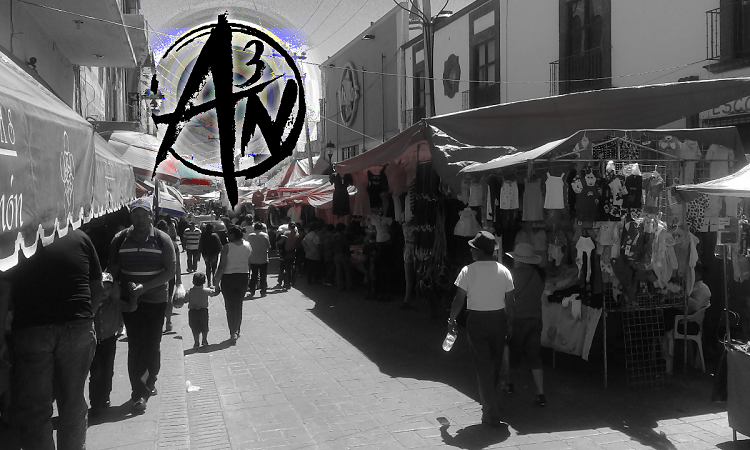
The Tianguis, Hallmark of Mexican Agorism
The tianguis is the hallmark of markets in Mexico. The word is the hispanicized form of the Nahuatl “tiyanquiztli”, which means “open air market.”
It has existed in Mexico for millennia since the advent of agriculture and the first urban settlements. It basically sets up in streets, squares, or any form of public space without the regulation of the police or the local government.
The area is secluded from automobiles and large tents are lifted to shelter the merchants and their products. In a typical tianguis, you can find pretty much everything: from agriculture supplies to electronics, from local wares to Chinese imports. You can find what they call “fayuca”, or smuggled merchandise from Europe and Asia, ranging from automobile parts to computer programming.
You can find all sorts of deliciously cooked food like the traditional fried grasshopers topped with garlic or fried frogs dipped in egg yolk from local lakes, or even deliciously-cooked goat broth with spices and chilli, as well as quality dark beer for the hangovers early in the morning.
You can find American brand clothing piled in disorganized mounts for twenty pesos a piece, which is nothing more than a dollar, and people inspecting the products trying to decide which one fits best. You can find antiques and even pieces of ancient prehispanic ceramic being sold, even when these artifacts are considered to be property of the state and its commerce illegal.
You can find animals sold for food or as pets, from dogs and cats to exotic reptiles and birds. There are even markets specialized in endangered species. You can find sorcery crafts and witchy merchandise produced both locally and internationally, supplying the religious demands of the region, like the cult for “La Santa Muerte”, or the “Holy Death”, enshrined mostly by cartels. You can find herbs, spices, insects, poisons, and minerals for both gastronomical and medicinal purposes. You can find shamans and physicians of the bones, or “hueseros”, as they call them, to give you body massages and remedies for old age.
You can find weapons, from daggers and knives to firearms. You can find pretty much anything if you know where to look.
It has been one of the most important forms of commerce since prehispanic times. So important that even after the Spanish Conquest, the Europeans mostly kept the tradition intact.
One of the most important markets during Aztec rule was the market of Tlatelolco. It was a vast market that was set up and dismounted every day of the week. It was the center of trade for the Aztec capital, the city of Tenochtitlan. It had its own governing system, comprising an assembly of twelve elders to solve disputes within the market. And as in any market place of ancient societies, the “tiyanquiztli” was also the social space for the trade of ideas. There, philosophers and ideologues from distant lands could meet and chat about the times, the technologies, and the political environment.
When Cortés, the Spanish Conqueror of Mexico, saw the market of Tlatelolco for the first time he said that it doubled the size of the city of Salamanca alone, so large it was, it could hall up to sixty thousand people daily, if not more.
“We turned to look at the great marketplace and the crowds of people that were in it, some buying and others selling, so that the murmur and hum of their voices and words that they used could be heard more than a league off. Some of the soldiers among us who had been in many parts of the world, in Constantinople, and all over Italy, and in Rome, said that so large a marketplace and so full of people, and so well regulated and arranged; they had never seen before..” –Bernal Díaz del Castillo, Spanish Conqueror.
Each kind of merchandise was kept by itself and had its fixed place marked out. Like the dealers of gold, silver, and precious stones, feathers, mantles, and embroidered goods. Then, the wares consisting of local slaves both men and women…Next there were traders who sold great pieces of cloth and cotton, and articles of twisted thread, and there were ‘cacahuateros’ who sold cacao.
There were those who sold cloths of henequen and ropes and the sandals with which they were shod, which were made from the same plant, and sweet cooked roots, and other tubers, and they all were kept in one part of the market in the place assigned to them.
In another part, there were skins of tigers [jaguars] and lions [pumas], of otters and jackals, deer and other animals, and badgers and mountain cats, some tanned and others untanned, and other classes of merchandise.
“Let us go on and speak of those who sold beans and sage and other vegetables and herbs, and to those who sold fowls, cocks with wattles, rabbits, hares, deer, mallards, young dogs… and let us also mention the fruiterers, and the women who sold cooked food, dough and tripe in their own part of the market; then every sort of pottery made in a thousand different forms from great water jars to little jugs, these also had a place to themselves; then those who sold honey and honey paste and other dainties like nut paste, and those who sold lumber, boards, cradles, beams, blocks and benches, each article by itself, and the vendors of ‘ocote’ [pitch pine for torches] firewood, and other things of a similar nature like paper, which in this country is called ‘ama[t]l’, and reeds scented with liquidambar, and full of tobacco, and yellow ointments and things of that sort are sold by themselves, and much cochineal is sold under the arcades which are in that great marketplace.
There are buildings where three magistrates sit in judgment, and there are executive officers… who inspect the merchandise. I am forgetting those who sell salt, and those who make the stone knives, and how they split them off the stone itself; and the fisherwomen and others who sell some small cakes made from a sort of ooze which they get out of the great lake, which curdles, and from this they make a bread having a flavour something like cheese.
There are for sale axes of brass and copper and tin, and gourds and gaily painted jars made of wood… Before leaving the marketplace itself, there were many more merchants, who, as I was told, brought gold for sale in grains, just as it is taken from the mines. The gold is placed in the quills of the geese of the country, white quills, so that the gold can be seen through, and according to the length and thickness of the quills they arrange their accounts with one another, how much so many mantles or so many gourds full of cacao were worth, or how many slaves, or whatever other thing they were exchanging…” – Bernal Díaz del Castillo.
And it wasn’t regulated at all, how could they? The Aztecs, unlike the Mayans, didn’t have a sophisticated system of writing to record debt, and for the same reason, they had no centralized currency. They used cacao beans, jade, and quetzal feathers as luxury item currencies, sometimes gold and silver, but it was barter. And the council of elders existed to solve disputes of “unfairness” but they were far from regulating value, or profit.
However there was tributation by force, fear, and religious propaganda. The city of Tenochtitlan was the seat of Tlaloc and Huitzilopochtli, the gods of Agriculture and War, and sacrifices would be performed daily, either vegetal, animal or human. And they would come from abroad the reaches of the Aztec domains, to offer tribute either voluntarily or by force.
By the time the Spaniards had ravaged the city to the ground, the tributation system and the regulation policies had turned in favour of a central currency, but the tianguis remained. The Catholic religion made its way to redirect tributation in honour of the Virgin of Guadalupe. And the “haciendas”, which were the states that regulated agriculture and mining, became the foundation of the Spanish colony. Yet the markets remained.
The Spaniards established commercial routes from Europe to America, and from America to Indochina, and the goods that flowed through them passed through the markets of Mexico, until the Colony met its decay and gave chance to civil war. But, even then, the local markets remained.
Modern nationalists and state propagandists deem it as part of the so called “informal economy” of Mexico, however it has been a pillar of traditional economy and culture within Mexico since ancient times. And will continue to do so, for the conditions of the land and the history of the cultures that have thrived within its social dynamics do not favour the formation of integral states capable of full regulation.
And there is a reason for this: the geography of the area favours sectarianism. Mexico is basically mountainous and human settlements are distant to each other. Pretty much like countries in the Middle East or the Mediterranean, mountain dwellers are not easy to subdue, even in the formation of large city states.
There has been forming a huge body of bureaucracy in the course of history to be sure, but it is corrupt and dysfunctional and unable to provide any infrastructure to regulate markets. However, they do serve multinationals that harm the local economy.
If you have the chance to visit any city in Mexico ask for the tianguis and the days of the week it settles, not all tianguis are equal, and they are an integral part of Mexican society.







